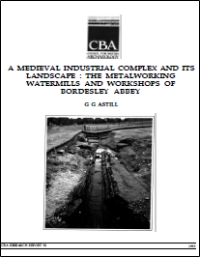CBA Research Reports
Council for British Archaeology, 2000. (updated 2020) https://doi.org/10.5284/1000332. How to cite using this DOI
Data copyright © Council for British Archaeology unless otherwise stated
This work is licensed under the ADS Terms of Use and Access.
Primary contact
Council for British Archaeology
92 Micklegate
York
YO1 6JX
UK
Tel: 01904 671417
Resource identifiers
- ADS Collection: 281
- DOI:https://doi.org/10.5284/1000332
- How to cite using this DOI
A Medieval Industrial Complex and its Landscape: The Metalworking Watermills and Workshops of Bordesley Abbey
G G Astill
CBA Research Report No 92 (1993)
ISBN 1 872414 43 5
Abstract

This is the third in the series of volumes reporting on work on the Cistercian abbey of Bordesley. This report descibes excavations and fieldwork undertaken between 1980 and 1991 in the eastern part of the precinct of Bordesley Abbey. The aim of the programme was to excavate the monastic watermills and workshops, and to elucidate the development of that part of the valley of the River Arrow in which the monastic precinct is located.
Contents
- Title pages
- Contents (pp i-v)
- List of Figures (pp v-viii)
- List of Plates (p viii)
- List of Tables (pp ix-x)
- Microfiche (pp xi-xii)
- Summaries - English, French, German (pp xiii-xv)
- Preface (pp xvi-xvii)
- Acknowledgements (pp xviii-xix)
- List of contributors (p xx)
- Excavations and field work 1980-1991, by G G Astill, (p 3)
- Circumstances and methods of excavation, (pp 3-7)
- The stratigraphy, report structure, and interpretation, (pp 7-8)
- Summary of chronology, (pp 8-9)
- The mill (BAB) stratigraphic sequence, (pp 9-65)
- The mill (BAB) structural timber sequence, by S J Allen, (pp 66-85)
- The valley transect (BAE) stratigraphic sequence, by period, (pp 85-98)
- Subsidiary excavations through the tail race (BAH and BAJ), by S Wass, (pp 98-102)
- The medieval and post-medieval landscape of the east part of the precinct: a new survey and interpretation, (pp 103-109)
- The finds, (p 110)
- Introduction, by G G Astill, (p 110)
- Stone (ST), by G G Astill and S M Wright, (pp 110-122)
- Flint (FL), by G G Astill, (p 123)
- Fuels (coal and charcoal), by G G Astill, (p 123)
- Baked clay (BC), by G G Astill, (p 124)
- Fired clay (FC), by G G Astill and S M Wright, (pp 124-129)
- Clay tobacco pipes (CP), by P Cannon, (p 129)
- Ceramic roof tiles and fittings, by G G Astill and S M Wright, (pp 130-141)
- Pottery, by V Nailor, (pp 142-163)
- Glass, by G G Astill, (p 164)
- Iron (IR), by I H Goodall; armour by I Eaves (pp 165-181)
- Metallographic examination of iron knives and other objects, by I Ridge, (pp 182-187)
- Copper alloy (CA), by G G Astill, (pp 188-196)
- Other metal: lead and silver (OM), by G G Astill, (pp 197-200)
- The nature and condition of the metalwork, by L Biek, (pp 200-202)
- Coins and jetton, by N J Mayhew, (p 202)
- Metalworking residues, by G G Astill, (pp 203-204)
- The valley environment: the evidence of the plant remains, by W J Carruthers, (pp 204-212)
- Molluscan analysis, by R Entwistle, (pp M2:B11)
- Worked wood (other botanical: OB), by S J Allen, (pp 213-231)
- Animal bone (AB), by J Lovett, (pp 231-235)
- Worked bone (WB), by G G Astill, (p 236)
- Leather (other animal: OA), by G G Astill, F Grew, and S M Wright, (pp 236-242)
- Dendrochronological analysis, by D Brown, (pp 242-245)
- Medieval technologies: water-power and industries at Bordesley Abbey by G G Astill, (p 246)
- The working of the Bordesley mills: the water supply, the mills, and their machinery, (pp 246-271)
- Metalworking at Bordesley and elsewhere: a review of the evidence, (pp 272-291)
- Other industries within the precinct, (pp 291-294)
- The supply of resources, the monastic economy, and the Arrow valley, (pp 295-302)
- Conclusion: the medieval landscape and the identification of industries - an ongoing agenda, (pp 303-304)
- Excavations and field work 1980-1991, by G G Astill, (p 3)
- Bibliography, (pp 305-311)
- Index by P Rea, (pp 312-317)
Download report
| A Medieval Industrial Complex and its Landscape: The Metalworking Watermills and Workshops of Bordesley Abbey (CBA Research Report 92) | 11 Mb | |
| A Medieval Industrial Complex and its Landscape: The Metalworking Watermills and Workshops of Bordesley Abbey (microfiche) | 4 Mb |







